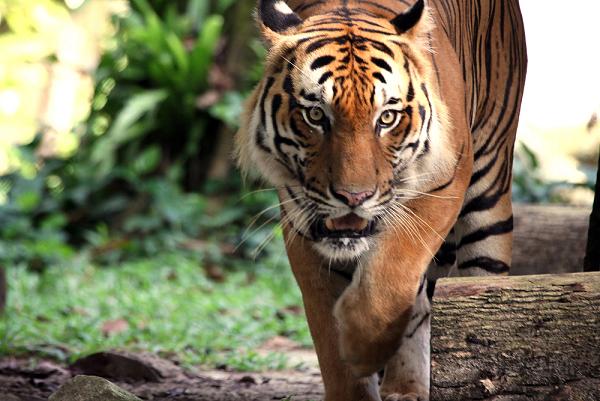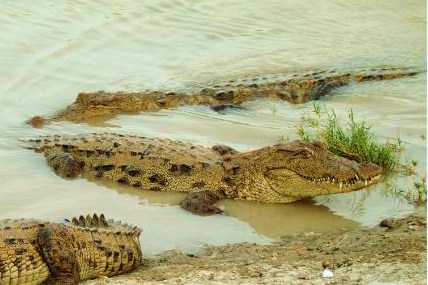Let’ s Go Wild for Wildlife! SGP welcomes the first World Wildlife Day
03 March 2014
 World Wildife Day, which was celebrated on March 3rd, 2014 for the first time, honors the many beautiful and varied forms of wild fauna and flora and raises awareness about the wide-ranging ecosystem benefits they provide. This day was chosen to commemorate the signing of the Convention on International Trade in Endangered Species of Wild Fauna and Flora (CITES) and draw attention to "the urgent need to step up the fight against wildlife crime, which has wide-ranging economic, environmental and social impacts" (UN). World Wildife Day, which was celebrated on March 3rd, 2014 for the first time, honors the many beautiful and varied forms of wild fauna and flora and raises awareness about the wide-ranging ecosystem benefits they provide. This day was chosen to commemorate the signing of the Convention on International Trade in Endangered Species of Wild Fauna and Flora (CITES) and draw attention to "the urgent need to step up the fight against wildlife crime, which has wide-ranging economic, environmental and social impacts" (UN).
This move also came in the wake of an ever-growing loss of biodiversity which may be the largest since the last great extinction 65 million years ago. According to IUCN, nearly one third of the 63,837 species examined worldwide are threatened with extinction. The main culprit is habitat loss due to poor land use practices, pollution, deforestation and desertification. Overexploitation is the second leading cause, and stems from unsustainable or illegal harvesting practices, including poaching and fish by-catch.
 The GEF Small Grants Programme (SGP) has supported thousands of community projects conserving wild species and their habitats across the world, in line with the objectives of the UN Convention on Biological Diversity (CBD). In addition, SGP projects in other focal areas contribute indirectly to species and habitat conservation by addressing land, forest or water degradation and climate change. Many of SGP's community-driven projects in national parks, biosphere reserves, wetlands, and marine protected areas are frequently clustered and coordinated to support larger, sub-national initiatives such as COMPACT, COMDEKS, GEF full-size projects and other partners' projects. The GEF Small Grants Programme (SGP) has supported thousands of community projects conserving wild species and their habitats across the world, in line with the objectives of the UN Convention on Biological Diversity (CBD). In addition, SGP projects in other focal areas contribute indirectly to species and habitat conservation by addressing land, forest or water degradation and climate change. Many of SGP's community-driven projects in national parks, biosphere reserves, wetlands, and marine protected areas are frequently clustered and coordinated to support larger, sub-national initiatives such as COMPACT, COMDEKS, GEF full-size projects and other partners' projects.
Over the years, SGP grantees from community-based organizations have come up with a range of innovative and easily replicable ideas to conserve precious wildlife species in their area. For example:
- In Namibia, the NGO Joint Presidency Committee produced chilies as an elephant deterrent and non-lethal alternative to minimize Human-Elephant Conflict (HEC). In another community, the CBO Koadi/Hoas Conservency helped livestock herders mitigate conflicts around water access points with desert-dwelling elephants by providing 'elephant-only' water points.
 In Malaysia, Citizen Action for Tigers (CAT), an initiative of the NGO Malaysian Nature Society, reduced the poaching of tigers and other endangered species in a priority wildlife corridor linking two of the largest remaining forest landscapes in Peninsular Malaysia.The protection program deters hunting and illegal logging while increasing surveillance at poaching hotspots through citizen conservationists who conduct watch walks in the corridor at times when the Wildlife and Forestry Departments are unable to do so. In Malaysia, Citizen Action for Tigers (CAT), an initiative of the NGO Malaysian Nature Society, reduced the poaching of tigers and other endangered species in a priority wildlife corridor linking two of the largest remaining forest landscapes in Peninsular Malaysia.The protection program deters hunting and illegal logging while increasing surveillance at poaching hotspots through citizen conservationists who conduct watch walks in the corridor at times when the Wildlife and Forestry Departments are unable to do so.- In Iran, the NGO Asian Leopard Specialists Society (ALSS) embarked on establishing a National Network for Participatory Conservation of the Persian Leopard to engage local communities in monitoring, research and conservation efforts. Mapping leopard habitats and available wildlife corridors, participants learned how to identify conservation priorities. They also learned about strategies to mitigate human-livestock-leopard conflicts, and about the consequences of intentional hunting and poisoning.
 In Cameroon, a project spearheaded by the NGO Community Action for Development (CAD) provided alternative livelihoods such as snail, poultry and pig farming, beekeeping, and vegetable gardening to reduce local bushmeat trade, unsustainable hunting practices, and encroachment into the Southern Bakundu reserve. It also trained wildlife management groups as monitors to check illegal hunting of endangered species such as chimpanzees and other threatened species. In Cameroon, a project spearheaded by the NGO Community Action for Development (CAD) provided alternative livelihoods such as snail, poultry and pig farming, beekeeping, and vegetable gardening to reduce local bushmeat trade, unsustainable hunting practices, and encroachment into the Southern Bakundu reserve. It also trained wildlife management groups as monitors to check illegal hunting of endangered species such as chimpanzees and other threatened species.- In Mauritius, the NGO Reef Conservation rehabilitated the marine life and biodiversity richness around a lagoon by establishing three Voluntary Marine Conservation Areas. In addition, it built the capacity of the committee to manage and monitor the conservation areas, and trained local fishermen as eco-guides for eco-tourism.
 In Tajikistan and Mongolia, the CSO Rushnoi and the NGO Green Forest Society (GFS), helped communities collect and conserv wild fruit tree seeds which they then made available to other communities in the region. Beyond conserving indigenous species, wild fruit tree orchards contributed positively to reforestation and land and soil rehabilitation. In Kyrgystan, the NGO Public Association «Uchkolot-Anarbek-Ata» (PAUAA) rehabilitated and conserved a walnut forest by underplanting wild growing species of stone fruit trees and bushes. In Tajikistan and Mongolia, the CSO Rushnoi and the NGO Green Forest Society (GFS), helped communities collect and conserv wild fruit tree seeds which they then made available to other communities in the region. Beyond conserving indigenous species, wild fruit tree orchards contributed positively to reforestation and land and soil rehabilitation. In Kyrgystan, the NGO Public Association «Uchkolot-Anarbek-Ata» (PAUAA) rehabilitated and conserved a walnut forest by underplanting wild growing species of stone fruit trees and bushes.- In Boliva, a project spearheaded by the NGO Asociación para la Conservación, Investigación de la Biodiversidad y el Desarrollo Sustentable (SAVIA) is currently conducting a series of participatory workshops to improve environmental governance capacities of communities, including indigenous and youth groups, around the Kaa Iya del Gran Chaco National Park to limit destructive land use and deforestation practices on the edges of the park. The Gran Chaco, which includes two Ramsar sites, provides 3.4 million hectares of precious habitat to more than 500 species of fauna and flora, including dozens of endangered species such as jaguars, armadillos, tapirs, monkeys, cactus, and orchids.
 In Yemen, the NGO Socotra Foundation for Bees Protection and Breeding (SFBPB) introduced domesticated bee-farming to the local community to relieve pressure on the wild bee population in Socotra. Wild bees had suffered from the ad-hoc, destructive harvesting practices of the community. The new bee-keepers also planted nectar producing tree species like Ziziphyus Sp. as multi-purpose use trees. In Yemen, the NGO Socotra Foundation for Bees Protection and Breeding (SFBPB) introduced domesticated bee-farming to the local community to relieve pressure on the wild bee population in Socotra. Wild bees had suffered from the ad-hoc, destructive harvesting practices of the community. The new bee-keepers also planted nectar producing tree species like Ziziphyus Sp. as multi-purpose use trees.- In the Bahamas, a project initiated by the NGO Bahamas Reef Environment Educational Foundation (BREEF) inserted an artificial reef to promote coral formation and provide nesting and breeding grounds for depleting fish stock. The initiative mitigated coral reef damage or loss due to climate change, ship groundings or other factors.
These examples provide useful insights into how localized action can contribute to the conservation of precious wild fauna and flora. In fact, participatory management methods have clearly shown how the engagement of local communities and their intimate knowledge of wildlife patterns are integral in improving human-wildlife relations. SGP is looking forward to continue working with communities, governments and its partners on conserving wildlife across the world.
(Source: www.sgp.undp.org) |